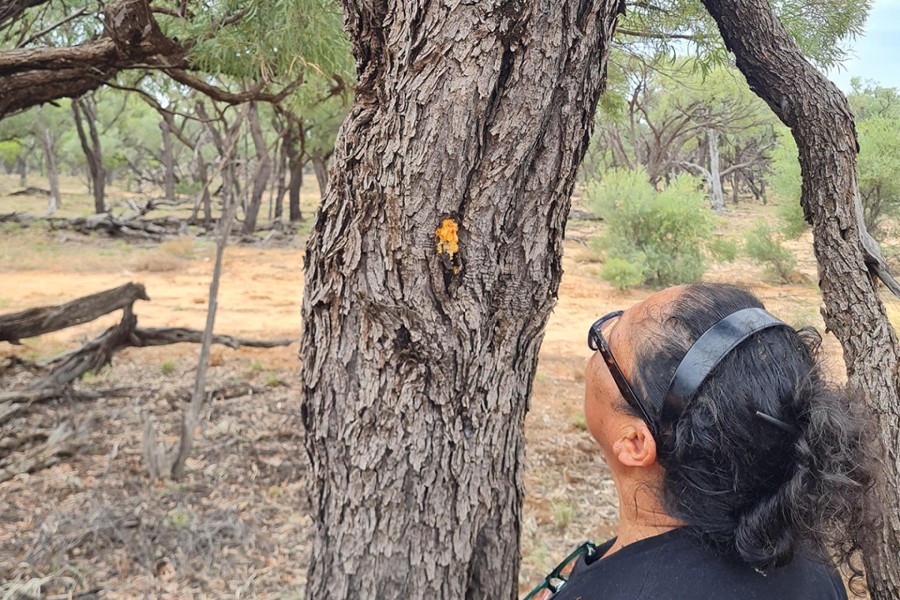
- Industry news
Industry news
- Category news
Category news
- Reports
- Key trends
- Multimedia
Multimedia
- Journal
- Events
- Suppliers
Suppliers
- Home
- Industry news
Industry news
- Category news
Category news
- Reports
- Key trends
- Multimedia
Multimedia
- Events
- Suppliers
Suppliers
Arabic gum alternative: Australian study finds promise for locally-sourced Gidyea gum
Key takeaways
- Gidyea gum matches gum Arabic in emulsification performance, with lower viscosity — offering advantages in clean label and high-solids food formulations.
- Australia could reduce dependency on imported hydrocolloids, building a resilient, locally sourced supply chain grounded in ethical engagement with Indigenous communities.
- Commercialization is underway, with pilot trials, sustainable harvesting plans, and opportunities for F&B companies to co-develop specifications and scale responsibly.

A study has found that sap from a tree common in inland areas of Australia shows potential as a replacement for the widely used, imported food and pharmaceutical ingredient gum, Arabic. Arabic is a substance excreted from an Acacia species and used to stabilize foods and drinks.
Food scientist Dr. Thomas Hay of the University of Queensland’s School of Agriculture and Food Sustainability tested gum from Acacia cambagei, also known as Gidyea or Marru.
The analysis showed that Gidyea gum has a similar structural composition to gum Arabic. For example, Gidyea gum’s performance was equal to gum Arabic in emulsifying an oil-in-water solution.
We caught up with Dr. Hay to discuss the research in depth and its potential implications for the F&B industry.

From a functionality standpoint, how does Gidyea gum compare with traditional gum Arabic in F&B formulations?
Hay: From a functionality standpoint, Gidyea gum performs very closely to gum Arabic. The macromolecular profile and its viscosity behavior were aligned with gum Arabic — it stabilized orange oil emulsions comparably over 15 days. It also showed lower solution viscosity at equivalent concentration, which is an advantage where pourability or high-solids processing matters. These results make it a promising candidate for emulsions and encapsulation.
Could this discovery allow Australia to reduce dependency on imported hydrocolloids, especially in light of recent global supply chain disruptions?
Hay: This discovery has strong potential to help Australia reduce reliance on imported hydrocolloids. Early results show Gidyea gum can work as an alternative to gum Arabic as an emulsifier. Our ongoing work is expanding the understanding of Acacia gum’s broader functional capacity. With Acacia cambagei growing widely across central Australia, and without the many social and economic challenges attached to other Acacia gum sources, there is a real opportunity here to build a reliable and locally sourced supply chain that strengthens our national resilience against global disruptions.
What are the next steps for scaling up Gidyea gum production for commercial supply, and how close are we to seeing it used in mainstream F&B products?
Hay: The next steps are already underway. Bringing a new ingredient into the market is complex. Scaling up means testing how consistent the Gidyea gum properties are across regions and seasons. There is also the legislation and food safety assessment to consider, but given that the gum is a traditional food source based on Indigenous cultural knowledge, there is already precedent for adaptation as an approved ingredient in the domestic market. Most importantly, the supply chain will be established through a networked cooperative to enable sufficient supply and fair, ethical benefit sharing with Indigenous communities.
How might F&B companies engage early with this emerging supply chain to test and integrate Gidyea gum into their formulations?
Hay: F&B companies can get involved by collaborating in pilot-scale trials and small batch formulations. Our proof of concept shows strong potential, and with early industry engagement, we can move toward assessing feasibility and building a scalable supply chain. The next steps for building a supply network are assessing the industry’s feasibility and scalability. Efficient assessment will need pilot-scale trials, and industry partners will provide excellent research-to-industry translation.
Gidyea gum harvesting has lower processing needs — how does this contribute to a lower carbon footprint or cleaner production for food manufacturers?
Hay: Exudate gums are typically collected and cleaned as hardened “tears,” then may be dissolved, clarified, and spray-dried for industrial use. In our research on Gidyea gum, we used a hydration and alcohol-precipitation method for purification at lab scale. The processing requirements of Gidyea gum are consistent with the gum Arabic practices, which is to say that it has a low carbon footprint and ecological impact.
How do you envision this industry developing in a way that balances commercial use with care for the environment and long-term biodiversity?
Hay: Balancing commercial demand with environmental care will be central to how this industry develops. The main risks are over-harvesting or a loss of biodiversity due to large-scale monoculture planting, but these can be managed by setting sustainable harvest limits and ensuring that collection remains minimally invasive. At this stage, the challenge in predicting the industry impact is knowing the yield of the Acacias contrast to future supply demands. We see the future of the Gidyea gum industry being built around a cooperative model that centralizes collection from a range of communities. This ensures fair benefit-sharing and supports Indigenous land stewardship and connection to the country, which in turn strengthens the way the land is cared for.
By spreading collection across regions and establishing new plantations in degraded, grazed areas, industrial impact can be minimized while restoration is supported. Gidyea thrives in fragile arid landscapes, and planting and maintaining these trees will create conditions for biodiversity to return. For farmers, heavily grazed land can gain added value from gum harvesting while also helping stabilize erosion-prone land. If developed carefully, Gidyea gum could stand as a leading example of how Australia can align new industries with cultural values, rural economies, and ecological restoration.
What signals or support would you like to see from major F&B companies to help bring Gidyea gum to market responsibly?
Hay: First, they commit R&D time and investment for trials in their priority applications. Next, they demonstrate an awareness of ethical Indigenous engagement and a willingness to learn best practices for engagement, including fair benefit-sharing with traditional owners. Finally, they co-develop a specification and QA framework (moisture, ash, protein, molecular weight distribution, interfacial performance) that de-risks commercial adoption.
Considering the majority of gum Arabic is sourced from regions facing environmental stress, how does your research position Gidyea gum as a more climate-resilient or ethical alternative for ingredient sourcing?
Hay: Australia is also facing climate stress and widespread land degradation from mining and grazing, but Gidyea represents a way to build resilience into the system. Rather than replacing gum Arabic outright, it can complement existing sources by diversifying global supply and reducing reliance on regions under strain. As an arid-suited hardwood, it can be planted across degraded rangelands, where few other crops can grow, supporting biodiversity recovery where it is most needed and adding to carbon capture. It’s an example of a smart-agricultural product that is supportive of landscape regeneration, which is sorely needed. The gum is also a chance for a new, Indigenous, self-determined industry that embeds consent and benefit-sharing from the get-go. That combination, a fit-for-place ecology, plus ethical sourcing, can help diversify the global supply of gums while respecting culture and country.










